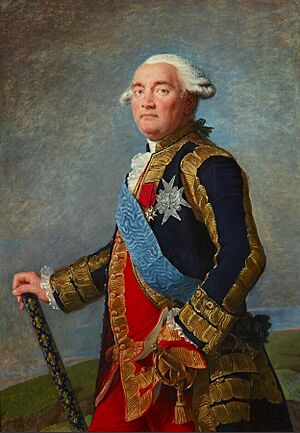Philippe Henri, marquis de Ségur facts for kids
Quick facts for kids
Maréchal de France
Philippe Henri de Ségur
Marquis de Ségur
|
|
|---|---|

Official portrait as Marshal of France by Élisabeth Vigée Le Brun in 1789
|
|
| Marquis of Ségur | |
| In office 19 June 1751 – 3 October 1801 |
|
| Preceded by | Henri François, Comte de Ségur |
| Succeeded by | Louis-Philippe, Marquis de Ségur |
| Secretary of State for War | |
| In office 23 December 1780 – 27 August 1787 |
|
| Preceded by | Charles Gravier, Comte de Vergennes |
| Succeeded by | Louis Charles Auguste Le Tonnelier, Baron de Breteuil, Baron de Preuilly |
| Personal details | |
| Born | 20 January 1724 Paris, Isle-de-France, Kingdom of France |
| Died | 3 August 1801 (aged 77) Paris, Seine-et-Marne, French Consulate |
| Military service | |
| Years of service | 1739–1787 |
| Battles/wars | Seven Years' War |
Philippe Henri, Marquis de Ségur (born January 20, 1724 – died October 3, 1801) was an important French nobleman and military leader. He was a grandson of Philippe II, Duke of Orléans. He became a Marshal of France, which is a very high military rank. He also served as the Secretary of State for War, managing the French army under King Louis XV and later King Louis XVI.
Contents
Biography of a French Leader
Early Life and Military Start
Philippe Henri de Ségur was born in Paris. His parents were Henri François, comte de Ségur and Philippe Angélique de Froissy. When he was just eighteen, he was put in charge of an infantry regiment (a group of soldiers). He fought alongside his father in Italy and Bohemia.
He was injured during battles. In October 1746, he was wounded at Roucoux in Flanders. The next year, in 1747, he lost an arm at the Lauffeld. In 1748, he took over his father's role as lieutenant-general for the regions of Champagne and Brie. He also became the governor of Foix in 1753.
Serving in Major Wars
Philippe Henri de Ségur played a part in the Seven Years' War. He fought in several important battles, including Hastenbeck (1757), Krefeld (1758), and Minden (1759). In 1760, he was captured during the Kloster Kampen.
Leading the French Army
In 1775, he showed great skill while governing the region of Franche-Comté. This led to his appointment as Minister for War in 1780, working under Jacques Necker.
As War Minister, he made important changes. In 1783, he created the first permanent general staff for the army. He also set up excellent rules for military barracks (where soldiers live) and hospitals. On June 13, 1783, he was promoted to Marshal of France. He left his role as War Minister in 1787.
Later Life
During a difficult time in France called the "Terror," he was put in prison. After he was released, he faced hard times. However, in 1800, he received a pension (regular payment) from Napoleon. He passed away in Paris the following year.
Family Life
Philippe Henri de Ségur married Louise Anne Madeleine de Vernon in Paris on February 3, 1749. They had two sons:
- Louis Philippe, comte de Ségur (1753–1830): He became a diplomat and a historian.
- Joseph Alexandre Pierre de Ségur, Viscount of Ségur (1756–1805): He was known as a poet, songwriter, and playwright.
Titles and Special Honors
Philippe Henri de Ségur received the honor of being a Knight of the Holy Spirit on June 7, 1767. This was a very prestigious award in France.


